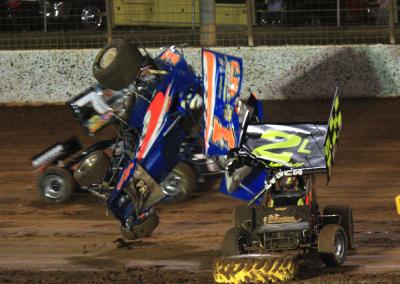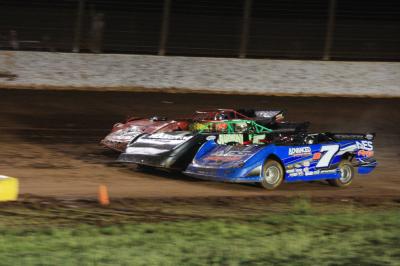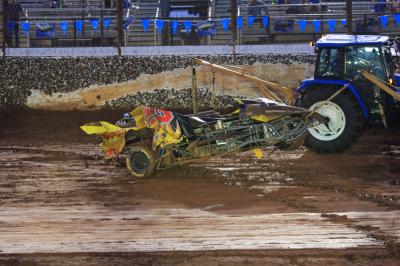
1. Pick a Class
Where are you going to race? What are the popular tracks in your area? What classes do they run? Before you can buy a used race car, you need to put some serious thought into what you are looking for and what you will do with it once you make a purchase. It sounds trivial, but there are plenty of racers that buy a car only to find out that the class is being phased out or that it was actually raced at a track several hundred miles away and that the owner just moved into the area.
When picking a class, consider your skill level. If you’ve never raced before, a Super Late Model or a 410 Sprint Car probably aren’t the cars you should pick to get your feet wet in. Don’t pick a class based on the class or event’s purse. Dirt racing has not been known to be a highly profitable venture at any level. Never assume that a division will be “easy” just because the cars are inexpensive. You will find many Street Stock and Four Cylinder drivers that have been running their divisions at their home track for over a decade. These guys are veterans and they can humble newcomers very quickly.
Don’t be discouraged, be reasonable. Planning ahead is one of the most beneficial things you can do. You don’t want to end up in a situation where you end up in a wreck and don’t have the money to fix your car, because you performed bad planning and are racing in a division outside of what you can afford.
Also, don’t forget to set goals. Do you want to run for a points championship? Are you trying to rack up wins? Your most important goal should be to have fun. When lofty expectations aren’t met, drivers become discouraged and racing becomes more frustrating than it does fun. The majority of people that get into racing do so simply because they enjoy it. However, once they are in the sport, they lose sense of that. Racing is a volatile sport – one minute you’re up, one minute you’re down. Be prepared for that.
2. Is It Straight?
The biggest thing you need to check for is whether or not the chassis is straight. Check the chassis thoroughly for cracks, or paint chips around welds. Make sure the tubing isn’t bent or damaged. Kaleb Hart, from XXX Race Components suggests that you get a look of the chassis while it is bare – with nothing else on it. This is the easiest way to know for sure where there may be an issue with a particular chassis. Check the quality of the welds. Make sure to look at it from multiple angles. Crawling on the floor to inspect a chassis may seem like an inconvenience, but it is a lot better than buying a chassis that is cracked and ready to come apart.
It is incredibly easy to put a new front or rear clip on a car these days and make it look brand new. While the front and rear clips may deceive you, the center section does not lie. Check the welds that connect the floorpan with the center sections of the car. When these are broken, you know that the center section has probably been tweaked.
High stress points exist where the roll cage connects to the front and rear suspension areas. Check these welds for wear and cracks, as they are the most likely to experience fatigue first. It is easier to see cracks on a chassis painted a light color, such as white, than it is one painted a dark color. If the owner is willing to let you, don’t be afraid to scrape off some paint to get a better look.
Inspect the firewall for bends and wrinkles. While people often replace a front clip, they rarely take the time to replace the firewall. This makes the firewall a good indicator of what the car has been through. Also, check for holes that have been drilled for wiring that are no longer in use. They can be an indicator to whether or not a different engine was in the car at some point.
The best way to check the car for straightness is to put it on the original jig the chassis builder used. If you can, contact the original chassis builder, he can probably tell you even more about the car and anything that looks out of place.

image credit: RedClayRebel
Never, let me stress, never, take someone else’s word that the car they are selling you complies with the rules at your track. Unless you know them personally and can specifically identify the car they are selling you, do not take their word as your final answer. Many racetracks have a Technical Director (“Tech Man” for short) that would be willing to accompany you to inspect the car you are contemplating buying. Your tech man should be your go-to person for rules. If you do this, make sure you let the chassis owner know your bringing the head tech official to inspect his car.
Sure, other drivers and track personnel may be able to offer you good advice, but no one knows the rules of your track better than the guy that enforces them each weekend. Popular to contrary belief, your tech man is your ally not your enemy. Use him to your advantage and don’t be afraid to ask him questions. It’s better to find out that the car you are about to buy doesn’t comply with the rules now than it is during post-race tech inspection after your first win.
4. Tech Support
Each of us has had at least one instance where we have had something break and had to spend hours on the phone with someone who barely speaks English and refuses to help us with our problem. You don’t want to be in that situation with your newly purchased racecar. Have someone that you can go to for help, setup advice and repair advice. Other racers may be good resources, or preferably, they can direct you to the people that work on their cars. It may not be free, but it is better to pay for some help than to sit in your garage helpless. Check the performance product and chassis shops in your area and develop contacts with them prior to making your purchase. If a race shop sponsors the track you are looking to race at, there is a good chance they work on the cars that race there. Have these contacts lined up ahead of time so you don’t find yourself scrambling for help when all hell breaks loose.
5. Best Car Ever
 It seems like every racecar for sale these days is a “Track Champion” or “Multiple Race Winner.” Don’t base your purchase on the title of the ad you find a car in. Take some time to learn the history of the car. If the car is indeed a track championship winning car, there is a pretty good chance it was driven hard and may have taken a heavier beating than another car may have. Yes, there are a lot of good racecars for sale, but that doesn’t mean every racecar for sale is a good one.
It seems like every racecar for sale these days is a “Track Champion” or “Multiple Race Winner.” Don’t base your purchase on the title of the ad you find a car in. Take some time to learn the history of the car. If the car is indeed a track championship winning car, there is a pretty good chance it was driven hard and may have taken a heavier beating than another car may have. Yes, there are a lot of good racecars for sale, but that doesn’t mean every racecar for sale is a good one.
Also, just because a car runs, that does not mean it is “race ready.” Many racers will advertise any car with a motor that fires up as race ready. There are a lot more components that make a car ready to race than the fact that it runs. Even if it is a true race ready car, you still may need to take it and have it set up to run your particular track. Depending on how similar the seller’s track is to the track you plan to race it on, this may be a costly venture. Talk to the person you plan to have set up your car. He will be able to let you know what adjustments need to be made before the car is truly race ready.
6. A Real Shocker
Okay, the car looks good, the frame is straight, and that’s all you need, right? Wrong. The fact is that racecars need constant maintenance. Parts need to be changed out regularly. There is a good chance that the used racecar you are looking at doesn’t have the newest of everything. The owner may have given it a good wash after its last race and left maintenance at that.
Just because the racecar you are looking at has four springs and four shocks on it doesn’t mean you’re golden. The old adage that “racers don’t screw racers” isn’t always true. Check the springs and shocks on the car and make sure they are the right ones for the car and for your track. You don’t want to go to shake the car down and find out that the seller threw his junk shock package on the car before he sold it to you. A good set of springs and shocks can cost you in the neighborhood of $1000. It may turn out that the hundred to a thousand dollars you just saved by buying one car over another is gone. If you don’t know what springs and shocks are good for your track, try to talk to other racers. If you don’t know any or you are unsure of their advice, your old friend the tech man should be able to provide you with a good range to look for.
7. Safety First

image credit: I-96Speedway.com
It sounds like more of a cliché than anything, but safety needs to be the top priority of any racer. So many racers make the mistake of spending a lot of money on making their car go fast and then choosing the cheapest option possible when it comes to safety equipment.
Check the dates on the car’s seatbelts, window nets and other safety components. If they are legitimate, they should have a tag that will provide you with this information. If you find these items are out of date, they can be often replaced inexpensively. However, the cost of all the replacements will add up quickly. Every single thing you need to do to the car between the time you buy it and the time you take it to the racetrack for the first time needs to be factored into the cost of the car when considering your purchase. Forgive me as I call on the cliché gods once again, but if a deal seems too good to be true, it probably is.
8. Knowledge is Power
Learn as much about the car as you can. Find out its date of manufacture, its race history, how many owners it has had, how many times it has been flipped – I could go on forever, but the more you know about the car, the better chance you will have at being satisfied with your purchase. Ignorance is bliss until you end up with your car sitting in the garage on a Saturday night and not at a racetrack because you didn’t bother to research it before you bought it. Don’t be afraid to ask around about the reputation of the seller. If it is a garage built chassis, learn about the history of the builder. Find out how many chassis he’s built and how his car performs.
Know how long the car has been around and how long it has been racing. The older the car is and the more races it has competed it, the more likely it is that something has happened to it.
Darrick Klima of BMS Modifieds points out that racecars are like any other piece of technology. There are constantly improvements and updates being made to cars. Every chassis and engine builder is constantly trying to come up with the next improvement that will make his customers go faster than the competition.
9 & 10. It All Adds Up
This has been mentioned already, but it cannot be stressed enough, every update you have to make to your car to get it ready to race needs to be factored into your purchase price and your decision. It is true that no part lasts forever, and a lot of inexpensive parts that need to be replaced can add up to a hefty bill. This can be very aggravating when you thought you were getting a good deal and saving money. There are often fairly expensive parts that often go overlooked. Make sure parts such as the gauges work, as these can be expensive to replace and a pain to install if they are not.
Yes, tie rods and ball joints are made to bend and warp before the more expensive parts of a car do. They are there to protect the more expensive parts of the steering system. While they are made to bend, inspect if they are bent. If they are, then the chances are that they are likely to go. Request for them to be replaced or use this to negotiate a lower price.
The increasing popularity of trail braking has lead to greater wear on brake rotors. While these are inexpensive to replace, they can cause a great amount of damage and even serious injury if they are not replaced at the right time. If they rear brake rotors are not new, it is probably worth it to replace them. There is no telling what a broken piece of a brake rotor may do when it flies off during a race at high speeds.
Be aware of what you are spending. The price of new equipment has come down significantly of what it was several years ago. Also, don’t feel like a private party purchase is the only way to get a good deal on a used racecar these days. Many dealers, such as BMS Modifieds, sell and guarantee used race cars. It may save a lot of headaches to have dealer support backing your purchase.
Thanks to Kaleb Hart of XXX Race Components, Darrick Klima of BMS Modifieds and 2011 East Lincoln Speedway Division Champion, Steve Newsome for contributing to this article.





